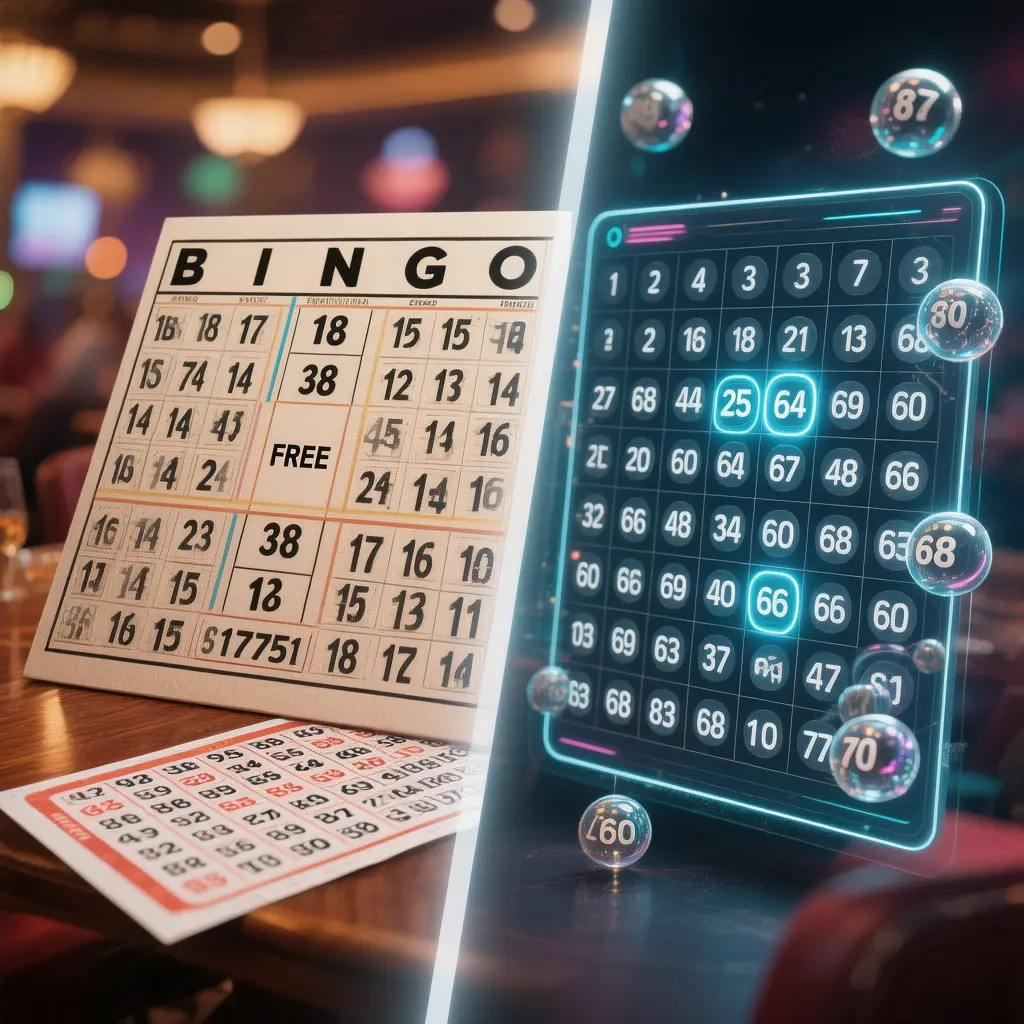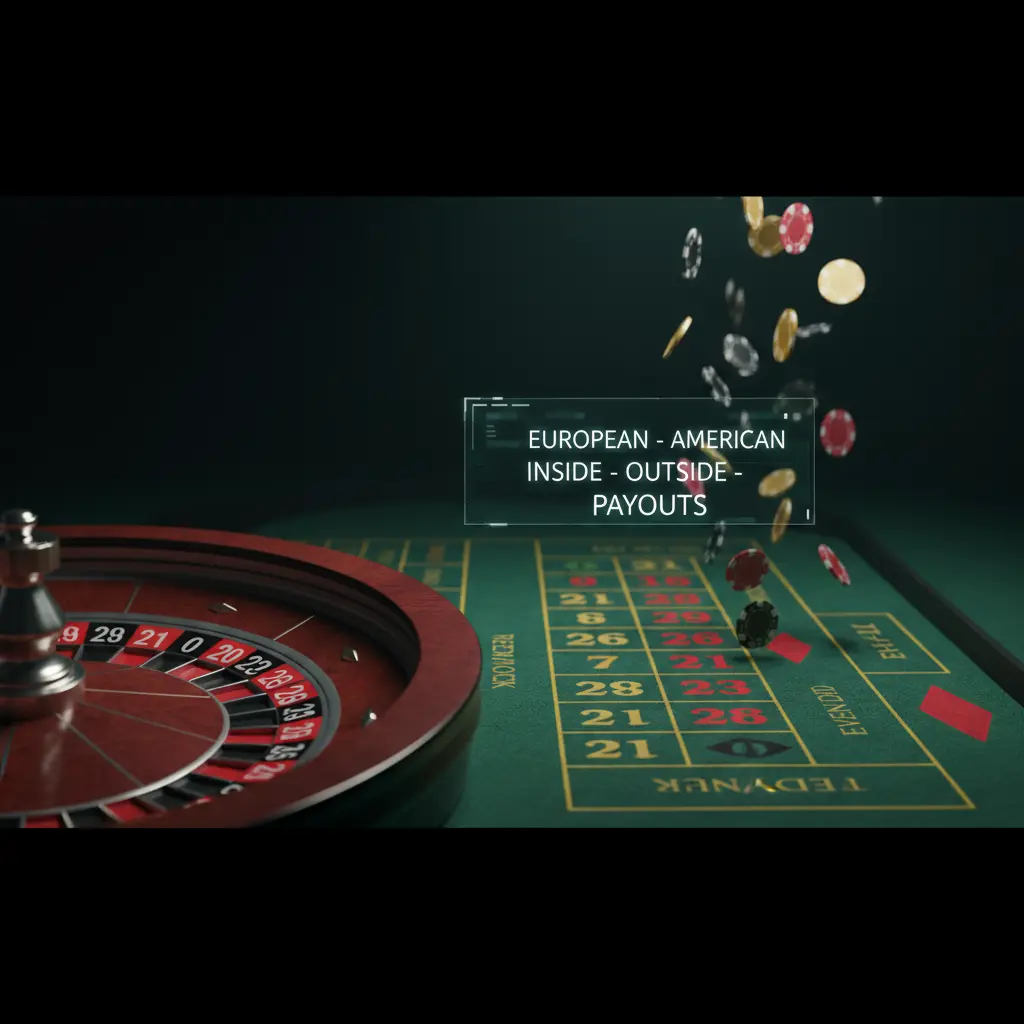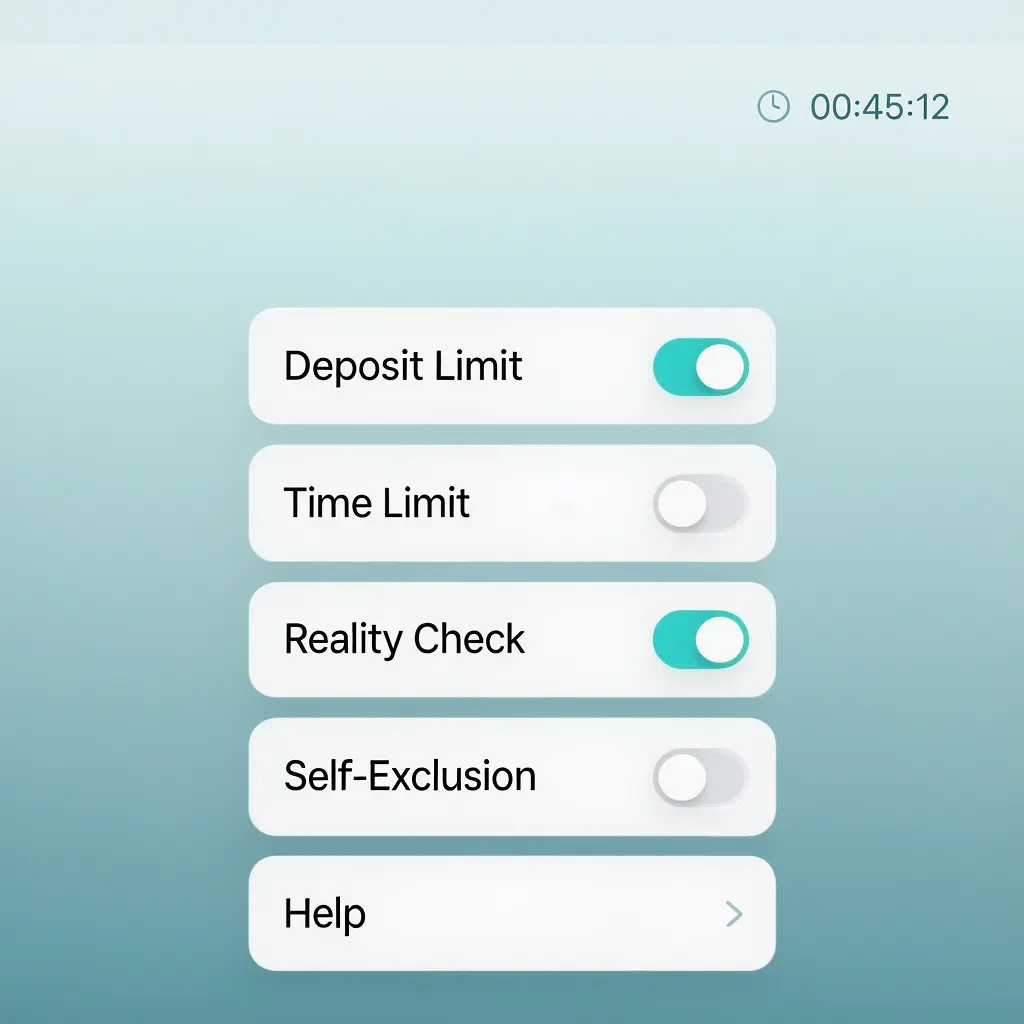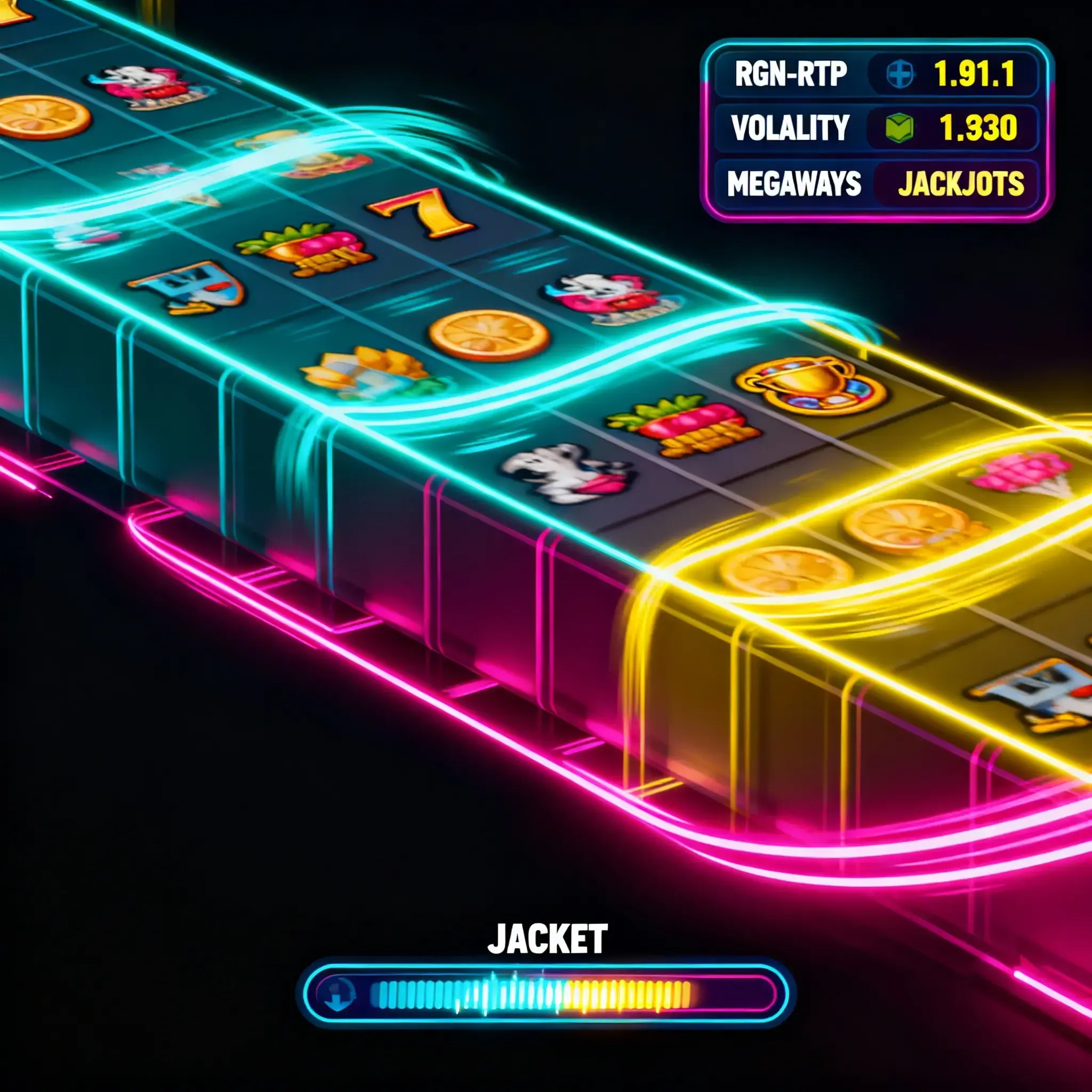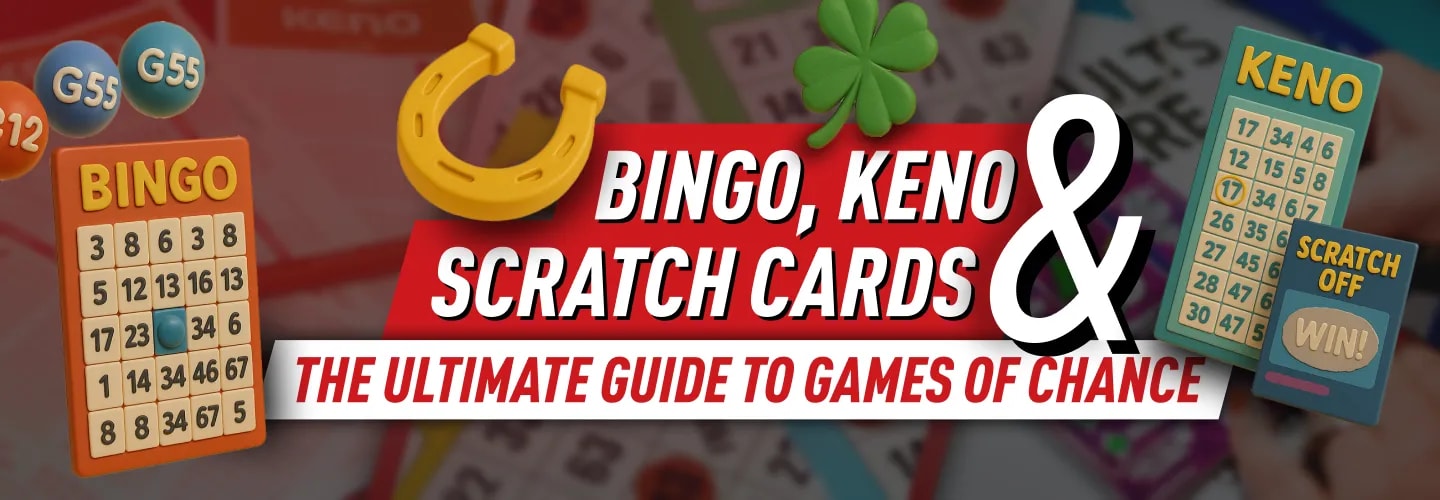
Welcome to the ultimate bingo and keno guide! If you’ve ever been curious about these exciting games of chance, you’re in the right place. While both are lottery-style games, they offer very different experiences. In Keno, you are the master of your fate, picking your own lucky numbers. In Bingo, you get a random card and enjoy the social thrill of the draw. This guide will break down everything you need to know, from the history and rules to understanding bingo cards, keno tickets, odds, and the key differences between playing online and in a live hall.
A Tale of Two Games: The Origins of Keno and Bingo
Before we dive into the rules and strategies, let’s take a quick trip back in time. Understanding where these games come from helps appreciate why they are so popular today.
Keno: The Ancient Game That Built a Wall
Keno’s story is the stuff of legends. According to historical accounts, its origins trace back to ancient China during the Han Dynasty, over 2,000 years ago. As the legend goes, the game was invented to raise funds for the state, and its revenue was so massive that it helped finance the construction of the Great Wall of China! The game, then called ‘;baige piao’ or “white pigeon ticket,” used carrier pigeons to send the winning results across the vast country. It arrived in the United States with Chinese immigrants in the 19th century and was eventually named “Keno” to sound more appealing and less like a “Chinese Lottery” during a time of anti-gambling laws.
Bingo: From Italian Lotto to Global Phenomenon
Bingo has a similarly rich history, starting in 16th-century Italy as a lottery game called ‘;Gioco del Lotto d’Italia’. The game traveled to France, where it was a favorite among the aristocracy. It wasn’;t until it reached the United States in the 1920s that it became the game we know today. An American toy salesman named Edwin S. Lowe saw a similar game called ‘Beano’ at a carnival. When a player excitedly yelled “Bingo!” by mistake, Lowe saw an opportunity, trademarked the name, and the rest is history. It quickly became a fundraising staple for churches and charities and has since grown into a billion-dollar global industry.
The Core Showdown: Keno vs. Bingo at a Glance
While both games involve matching numbers on a card, their gameplay mechanics are fundamentally different. This is a crucial part of our bingo and keno guide. Here’s a simple breakdown of their key differences.
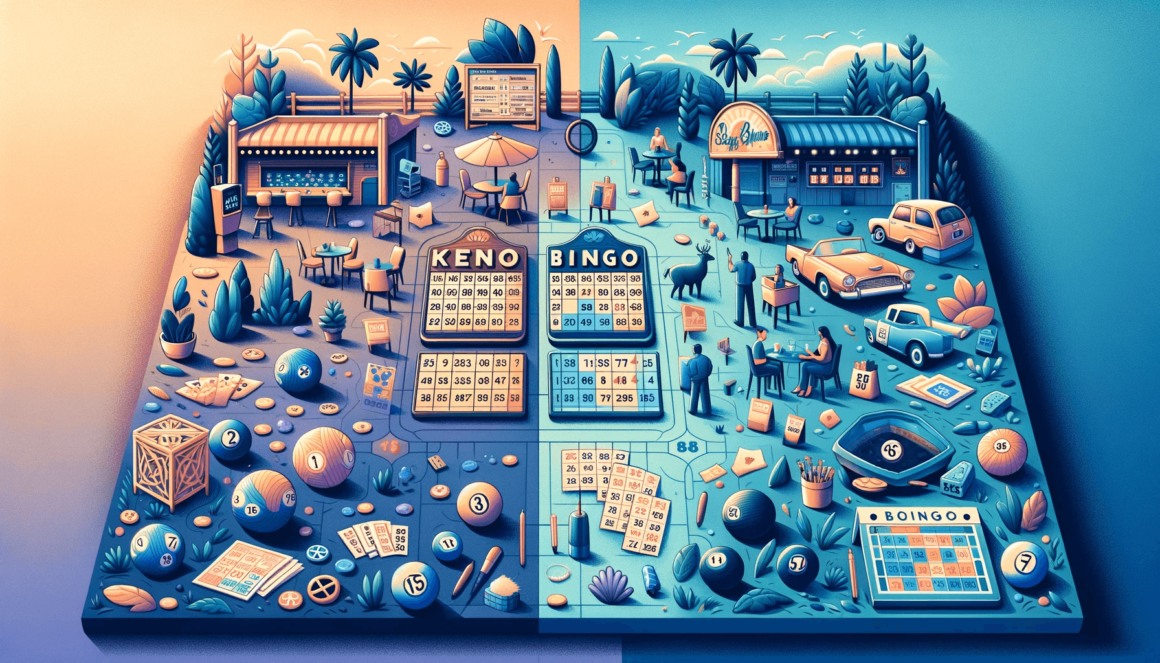
| Feature | Keno | Bingo |
|---|---|---|
| Player Action | You actively choose your own numbers (called ‘spots’) from a pool of 80. | You receive one or more cards with pre-filled, random numbers. |
| Pace of Game | Very fast-paced. A new draw can happen every few minutes, especially in online keno. | Slower and more social. You wait for a caller to announce each number one by one. |
| Player Control | High. You decide how many numbers to play and how much to bet on them. | Low. Your only real choice is how many bingo cards to play at once. |
| Objective | To match as many of your chosen numbers as possible to the 20 numbers drawn. Payouts vary based on hits. | To be the first player to complete a specific pattern (like a line or a full house) on your card. |
| Social Aspect | Generally a solo game, played against the house. | Highly social, played against other players in a hall or online community rooms. |
Diving Deep into Keno: Your Ultimate Guide
Now that you know the basics, let’s explore Keno in more detail. This part of our bingo and keno guide will turn you into a confident Keno player.
Understanding the Keno Card and Spots
A standard Keno game is simple. You get a keno ticket or see a digital card with numbers 1 through 80. Your job is to pick the numbers you think will be drawn. These chosen numbers are called “spots.”
- The Grid: A Keno card displays 80 numbers, usually in a 10×8 grid.
- Picking Spots: Traditionally, you could pick up to 10 spots. However, many online Keno games allow you to pick up to 15 or even 20 numbers.
- What are keno spots and payouts? The number of spots you choose directly impacts your potential payout. The more spots you try to match, the higher the top prize, but the harder it is to win. The keno pay tables clearly show how much you win for catching a certain number of your spots.
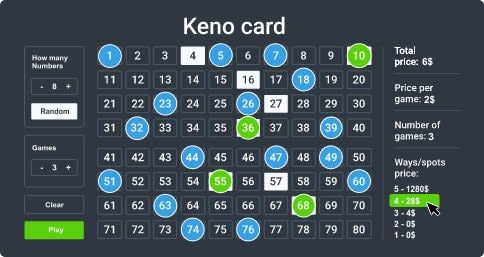
How to Play Keno: A Step-by-Step Guide
Ready to play? To learn keno rules is easy. Just follow these simple steps:
- Select Your Keno Card: Whether online or offline, you’ll start with a card showing numbers 1-80.
- Choose Your Numbers (Spots): Pick anywhere from 1 to 20 numbers, depending on the game’s rules. You can pick them manually or use a “Quick Pick” feature to have them randomly selected for you.
- Decide Your Bet Size: Choose how much you want to wager per draw. You can also decide to play the same numbers over multiple consecutive draws.
- Watch the Draw: The game begins! A total of 20 numbers are drawn at random from the pool of 80. In online games, a Random Number Generator (RNG) does this instantly. In live venues, a physical ball machine is often used.
- Check for Matches and Payouts: The game will automatically show you how many of your spots you “caught” (matched). Your winnings are based on the number of matches, your bet amount, and the game’s pay table. Interestingly, some Keno variants even offer a small prize for catching zero numbers if you picked a high amount of spots!
Keno Payouts, Odds, and RTP Explained
This is where Keno gets interesting. The odds and payouts change dramatically based on how many spots you play. This is a key concept in any bingo and keno guide.
Keno Payouts Explained
The keno pay table is your best friend. It shows you exactly what you can win. For example, picking 10 spots and hitting all 10 could win you a massive jackpot. Hitting just 5 of those 10 might win you a much smaller prize. The keno RTP by number of picks varies, but generally, the house edge in Keno is quite high, often between 15% and 40%. This means that for every $100 bet, the casino expects to keep $15-$40 over the long run. It’s a game of high risk and high reward!
- Keno Odds: The odds of hitting all 20 numbers on a 20-spot ticket are astronomical (about 1 in 3.5 quintillion!). That’s why jackpots are usually won by hitting a smaller subset, like 9 out of 9 spots or 10 out of 10 spots.
- RTP Ranges: The Return to Player RTP in Keno is typically lower than games like Blackjack. Some online RNG versions can offer better RTP, sometimes over 90%, so it pays to check the game’s info.
- Volatility: Keno is a high-volatility game. This means you might have long streaks with no wins, followed by a very large payout. It’s important to manage your bankroll accordingly.
Becoming a Bingo Pro: A Complete Guide
Let’s switch gears to the social and exciting world of Bingo. If you want to learn bingo rules, this section of our bingo and keno guide has you covered.
Getting to Grips with Bingo Cards and Patterns
Unlike Keno, you don’;t pick your numbers in Bingo. You buy bingo cards, and the fun is in seeing if the randomly drawn numbers match what’s on your card.
- 75-Ball Bingo (U.S. Style): Played on a 5×5 grid with a free space in the middle. The columns are labeled B-I-N-G-O.
- 90-Ball Bingo (UK/European Style): Played on a 9×3 card. Each row has five numbers and four blank spaces.
- Bingo Patterns Explained: The goal isn’t just to match numbers, but to match them in a specific shape or pattern. Common patterns include:
- Line Patterns: A single horizontal, vertical, or diagonal line.
- Full House Pattern: Covering every single number on your card. This usually wins the biggest prize.
- Other Patterns: There are hundreds of other patterns, like a postage stamp (a 2×2 square in a corner) or a blackout (same as a full house).
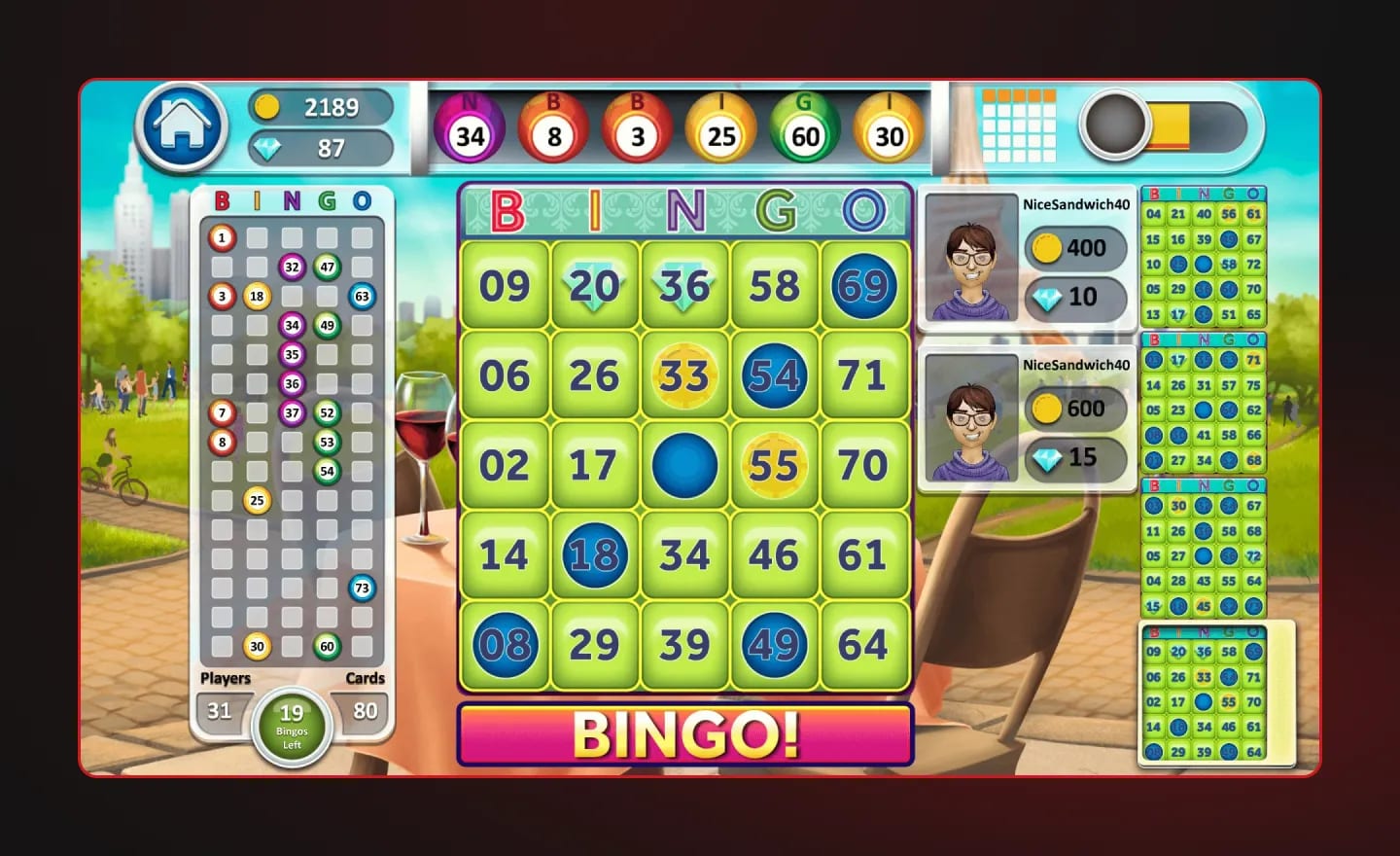
How Online Bingo Works vs Live: The Rules
The core rules of Bingo are the same whether you’re in a bustling hall or on your couch.
- Buy Your Cards: In a live hall, you buy paper cards or an electronic terminal. Online, you purchase digital ticket strips.
- The Draw Begins: A “caller” announces numbers one by one as they are drawn from a machine.
- Daub Your Numbers: When a called number appears on your card, you mark it off (or “daub” it). One of the biggest perks of online bingo is the auto-daub feature, which marks the numbers for you so you never miss one!
- Call “BINGO!”: Once you complete the required pattern, you shout “BINGO!” to claim your win. Online, the software does this for you automatically.
Bingo Odds and RTP Ranges
Understanding bingo odds explained is simpler than Keno. Your chance of winning is directly related to how many cards are in play.
- Bingo Odds: If there are 100 cards in a game and you have 1 card, your odds of winning are 1 in 100. If you have 5 cards, your odds improve to 5 in 100 (or 1 in 20). It’s that simple!
- Bingo RTP Range: The house edge in Bingo is typically between 5% and 15%. This means the bingo rtp range is generally 85-95%. The prize pool is funded by the ticket sales, and the operator takes a small percentage.
The Digital Revolution: Online vs. Live Play
Playing online has changed the game for both Bingo and Keno. Here’s a look at the pros and cons of playing online versus in a live venue, a vital part of any modern bingo and keno guide.
| Feature | Online Play (Keno & Bingo) | Live Venue Play (Keno & Bingo) |
|---|---|---|
| Pace & Convenience | Play anytime, anywhere. Games are much faster (e.g., instant keno, speed bingo). | You must travel to a specific location. Games are slower, with set draw times. |
| Game Variety | Huge variety of themes, jackpots, and rule variations. | Limited to the games offered by that specific venue. |
| Social Experience | Social via chat features and community rooms, but it’s a digital interaction. | A true social event. You’re in a room with other people, sharing the excitement. |
| Helpful Features | Auto-daub in Bingo and Quick Pick in Keno make playing effortless. | You are responsible for marking your own cards and keeping up with the caller. |
| Bonuses & Costs | Many sites offer welcome bonuses. Ticket cost vs payout can be very flexible. | May offer casino perks or freebies. Ticket prices are fixed. |
The Role of RNG in Bingo and Keno: Is it Fair?
A common question from new players is whether online games are rigged. The short answer is no, as long as you play at a licensed and reputable site. This is where the Random Number Generator (RNG) comes in.
RNG Bingo Fairness Explained
An RNG is a complex computer algorithm that produces a sequence of numbers that is completely random and unpredictable. In online Bingo and Keno, the RNG determines which numbers are drawn. Reputable gaming authorities and third-party auditors regularly test these RNGs to ensure verified fairness. This guarantees that every draw is independent and every player has a fair chance to win. The RNG bingo explained simply is that it’s the digital equivalent of a physical ball machine, but with mathematical proof of its randomness.
Frequently Asked Questions (FAQs)
Q1. How do you play keno and win?
You win Keno by matching the numbers you pick (your “;spots”) to the 20 numbers drawn by the game. The more numbers you match, the more you win. Payouts are listed on the game’s pay table and depend on how many spots you chose to play and how many you successfully “caught.”
Q2. What are the odds of winning keno?
Keno odds vary greatly depending on how many numbers you pick. For example, the odds of hitting one number on a one-spot ticket are roughly 1 in 4. However, the odds of hitting 10 out of 10 spots are in the millions. It’s a game of high risk for high reward.
Q3. How is Bingo different from Keno?
The main difference is player choice. In Keno, you actively pick your own numbers to bet on. In Bingo, you are given a random card and you play against other people to be the first to complete a pattern. Keno is a solo game against the house, while Bingo is a social game against other players.
Q4. Can you play Bingo and Keno online on your phone?
Absolutely! Most modern online casinos and bingo sites are fully optimized for mobile devices. You can play a huge variety of RNG versions of both games directly from your smartphone or tablet’s web browser or through a dedicated app.
Q5. What is the best keno strategy?
There is no strategy that guarantees a win, as Keno is a game of pure luck. However, many experienced players suggest a bankroll suggestion of sticking to a budget. A common playing strategy is to pick between 4 and 8 numbers, as this range often provides a good balance between achievable odds and attractive payouts.
Q6. How do you improve your chances of winning Bingo?
Since Bingo is also a game of chance, you can’t influence the numbers drawn. However, you can improve your statistical odds of winning by (1) playing more cards per game, and (2) playing in games with fewer players. The more cards you have, the higher your share of the total cards in play.
Q7. What does RTP mean in Bingo and Keno?
RTP stands for “Return to Player.” It’s a percentage that represents how much of all wagered money a game will pay back to players over time. For example, a game with a 90% RTP will, on average, return $90 for every $100 bet. The keno rtp range is often lower (60-85%) than the bingo rtp range (85-95%).
Q8. Are online Bingo and Keno games rigged?
No, not at licensed and regulated online casinos. These sites use a Random Number Generator (RNG) to ensure that every number drawn is completely random and fair. These systems are regularly audited for verified fairness by independent testing agencies.
With over 20 years of experience in the iGaming industry, Anilgnews provides expert analysis and in-depth content to help players and operators navigate the complexities of online gambling regulation.

